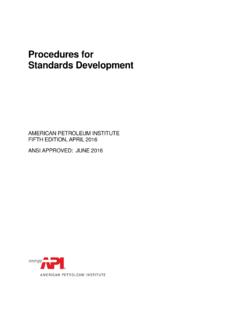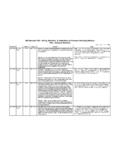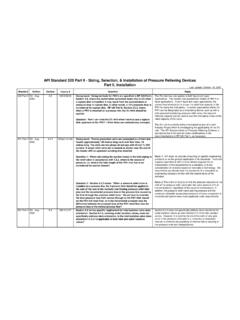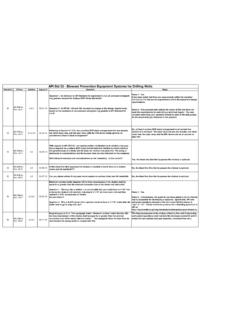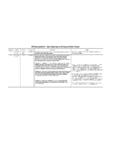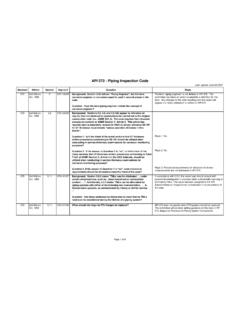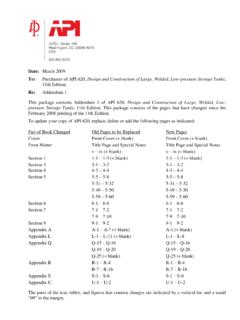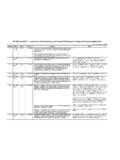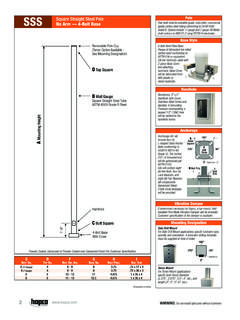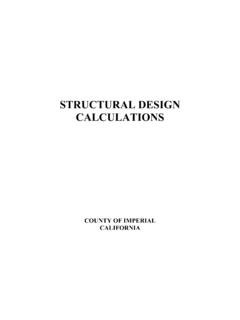Transcription of Technical Inquiries for API Standard 650, Welded Tanks for ...
1 SectionEditionInquiry InquirySCAST ReponseMultipleEd 12, Ad 0650-2013-F8 May astm a500 cold formed round structural tubing be substituted for astm A53 pipe for round structural members such as floating roof legs, for roof support columns, etc?Yes subject to the provisions of Para. , including - Nov. 1998Do the current rules in API 650 allow for a carbon steel tank to incorporate stainless steel components such as nozzles or an entire shell ring, provided all requirements of API 650 are followed for each of the particular material types (CS or SS) used in the structure?No. For a carbon steel tank, API 650 does not allow the use of materials that do not comply with the specifications listed in Section - May 1993 Does API 650 permit the substitution of Charpy impact testing in lieu of meeting specified chemistry requirements? - May 1993 What API group number is A 36?A 36 can be a Group I or Group II material, if it complies with the respective footnotes in Table 2-3 of API - Nov.
2 1998650-I-06/041: Does the in. thickness tolerance specified for plate in API 650, apply to carbon and stainless coil product?2: When purchasing hot-rolled coil-processed steel for use as roof, shell, and/or bottom plate on a stainless tank, does the astm under-run tolerance apply?1: Yes. All requirements of the base document apply to an Appendix S tank unless specifically changed or waived by a statement in Appendix S. Refer to : The minimum of the astm tolerance or as specified in API 650, Sections , , or , shall - May 1993 Referring to Section , does the phrase "experience or special local conditions justify another assumption" mean that a tank is permitted to be designed for temperatures higher than the specified 15 F above the lowest one-day mean ambient temperature of the locality if the stored product was "normally warmer" than this specified temperature?
3 No. The Section is referring to variations in local climatic conditions that might not show up on the isothermal charts. However, the document does not yet provide data for locations not covered in Figure 2-2, such as Alaska and - May 1993Is it permissible to use Group I plates for a tank bottom, except for plates Welded to the shell, for Tanks with a -50 F design metal temperature?API 650 only addresses toughness of bottom plates Welded to the shell, per Section or 2-39th - May 1993 Does Table 2-3 only relate to plates that are to be heat-treated? 2-39th - May 1993 Does API 650 require that all A 36 material be killed or semi-killed?Yes, see Table 2-3, Note - Nov. 1998650-I-11/01 Does API 650 require that the material used for the tank shell is of the same group that the material used for manhole reinforcement plates?No, see Section - Nov. 1998650-I-49/02 Does API 650 limit the thickness of Group I, Grade 250 steel plate to 25 mm (1 in.)
4 ?No, however, API 650 does require that the material be impact tested, if the thickness is greater than that allowed by the exemption curve in Figure - Nov. 1998650-I-33/03 Are roof materials required to meet the toughness requirements in Refer to - Nov. 1998650-I-44/03 Does API 650 require manganese content between and for A 36 plate less than in. to be classified as a Group II material?Yes. Refer to Table 2-3b, Note 6. Otherwise, the plate would be classified as Group - May 1993 Referring to API 650, does A 36 plate material meet the requirements of Section However, the use of A 36 material also requires that other conditions, such as those described in Figure 2-1 and Table 2-3, and their notes, are - May 1993 Does the thickness limitation of 1 in. for A 283 Grade C plates specified in Section of API 650 apply to the type of plates used in construction of a tank, such as the thickness of the bottom reinforcing plate and bolting flange and cover plate for flush-type cleanout fittings in Table 3-12?
5 - May 1993 Should the yield strength reduction factor also be applied to the and terms of Section when determining the allowable stress S? - Nov. 1998650-I-15/001: For nozzles made from pipe materials, does API 650, Section require that seamless pipe be used for nozzles in shells made from Group I, II, III, or IIIA materials?2: Does API 650, Section. preclude the use of electric-resistance Welded pipe meeting astm A 53, or electric- Welded pipe meeting API 5L, for nozzles in shells made from Group IV, IVA, V, or VI materials, but allow use of electric-fusion- Welded pipe nozzles made from astm A 671?1: Yes, unless astm A 671 pipe is : Inquiries for API Standard 650, Welded Tanks for Oil StorageLast Updated August 2016. (New Additions for 2016 are Highlighted in Yellow)Important Note: The API inquiry process is intended to help users understand the Technical requirements in the Standard without providing the intent, background, and Technical basis.
6 The posted interpretations (responses) to Inquiries are based on the Standard s edition/addendum in effect when the interpretation was prepared. Before applying any interpretation, always look for a later interpretation (if one exists). If there is a conflict between interpretations, use the latest interpretation. If there is a conflict between an interpretation and the current issue of the Standard , use the current of 25 SectionEditionInquiry InquirySCAST - May 1993 Referring to API 650, Section , are bolt heads required to be marked according to ASME Section II, Part A for bolting?No. Refer to the applicable astm bolt specification, which may or may not be identical to the parallel ASME bolt - May 1993 Please furnish details on the maximum allowable tank diameter and height for Tanks built in accordance with API appropriate combination of tank diameter and height is a design consideration.
7 There are several factors which influence this. API 650 does not cover an explanation of these factors. Please note the thickness limitations given in Section - Nov. 1998650-I-37/03Is it the intent of to limit the maximum lap of a double Welded lap joint to 2 in. and a single Welded lap joint to 1 in. If not, is there a maximum lap requirement for single Welded lap joint bottoms and roofs? Would this constraint, if any, also apply to bottom or roof repair or replacements governed by API - Nov. 1998650-I-49/031: Section of API 650 specifies minimum lap joint dimensions. Is there any limit on the maximum width of a lap joint?2: Can a lap joint consisting of two (2) in. plates be lapped 3 : API Standard 650 does not address maximum : Yes. Any lap that exceeds the minimum is acceptable. Refer to - May 1993 What is the distance between vertical welds?Please refer to API 650, Section and Section 3-3a9th - May 1993650-I-24/98 Referring to API 650, Section and Figure 3-3a, is it permissible to lap roof plates with the inner (upper) plate lapping under the lower (outer) plate, to protect against the tank contents condensing in the lap joint on the underside of the roof?
8 Yes, the details shown represent the typical or most common details, but other details are also - May 1993 Referring to API 650, Section , is it required to make a full fillet lap seam weld (top side only) under the tank shell? - Nov. 1998650-I-52/02 Referring to Section , for lap Welded bottoms and roofs, are Standard mill edge plates considered to be reasonably square edged ? - Nov. 1998650-I-02/041: Referring to API Standard 650 (b) and Figure 3-20, is it mandatory to provide welding between the bottom-side of a wind girder plate/section and the tank shell if not specified by the purchaser?2: Is it mandatory to seal-weld the bottom of the weld joints joining ring sections of the wind girder?1: This is a purchaser specified option for details a, b, c and e of Figure 3-20. It is required for detail d of Figure 3-20. 2: Section (a) requires this to be a full-penetration - Nov.
9 1998650-I-11/02Is there any allowance or provision to omit the top angle as required by API 650, and if we can show by calculation that the top compression area is - May 1993 Does API 650 cover the design of a tank for a design vacuum condition of 50 mm of water?No. Per API 650 Section , the tank is limited to one in. of water vacuum (roughly 25 mm). If the tank must be designed for 50 mm water vacuum, then this is a special design which is not covered by API - May 1993 Should the vacuum relief system set pressure be 25 mm of water if the required design vacuum condition is 50 mm of water?API 650 does not cover the required setting for vacuum relieving systems. The vacuum relieving systems should be adequately sized to limit the partial vacuum to 1 in. of water vacuum (roughly 25 mm of water). Refer to API Std. 2000, Section - Nov. 1998650-I-20/03 Can Tanks that are designed to exceed 1 in.
10 External pressure have an API nameplate?Yes. API 650 does not contain design rules covering external pressure exceeding 1 in. water - May 1993Is a repad allowed to go to the tank bottom and intersect the bottom at 90 degrees to the bottom? - Nov. 1998Is it acceptable for the primary (upper) bottom, of an API 650 Appendix I double-bottom tank to not project through the shell and to be attached only to the inside of the shell?No. API 650, Section requires the bottom plate project at least 25 mm (1 in.) outside the toe of the outer shell-to-bottom weld. Section requires the annular plate project at least 50 mm (2 in.) outside the shell. Furthermore, Section requires the bottom be Welded to the shell on both sides of the shell. The only way this can be accomplished is with a shell projection. Figure I-4 illustrates an acceptable double-bottom - Nov. 1998 Can a bottom rectangular plate, as described in API 650, Section , be smaller than 72 in.
